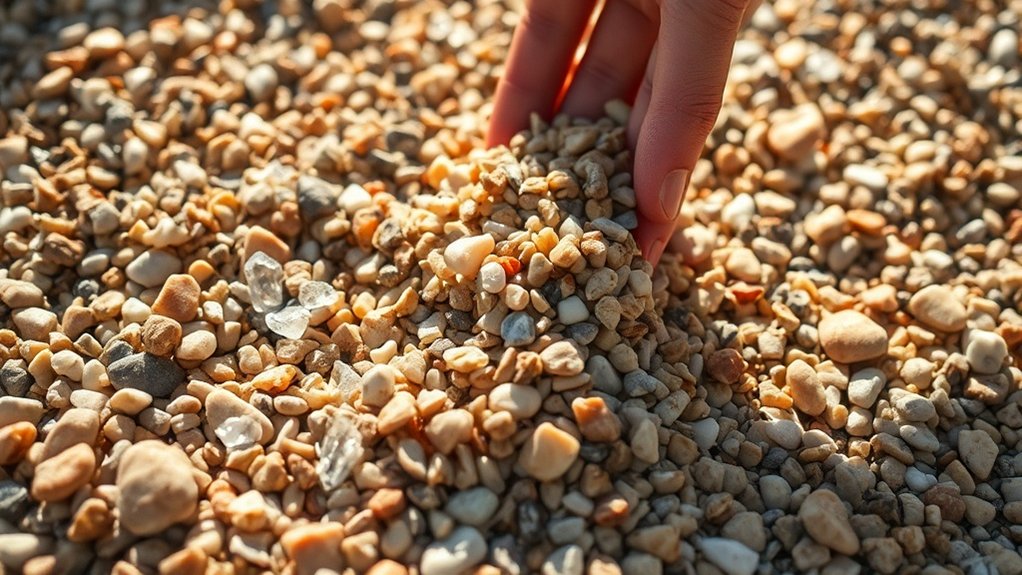When choosing aggregates for high-traffic resin-bound gravel areas, select sharp-edged, high-quality aggregates around 14mm for better bonding and durability. It’s essential to use washed, kiln-dried materials to avoid moisture problems and ensure effective drainage. Look for aggregates with suitable porosity and size to improve permeability and reduce standing water issues. Don’t forget about aesthetics; mixing different colours and textures can enhance the visual appeal. By considering these factors, you’ll boost both the performance and lifespan of your surfaces.
Key Takeaways
- Choose hard, abrasion-resistant aggregates to reduce wear and extend the lifespan of surfaces in high-traffic areas.
- Select aggregates with sharp edges to improve mechanical interlock, creating a strong, durable surface.
- Ensure aggregates are thoroughly washed and kiln-dried to avoid moisture issues with the resin.
- Opt for a consistent aggregate size around 14mm, with a resin layer at least three times thicker to maintain structural integrity.
- Pick aggregates that offer good porosity and permeability to promote effective drainage and minimise the risk of standing water.
Understanding Aggregate Size and Type
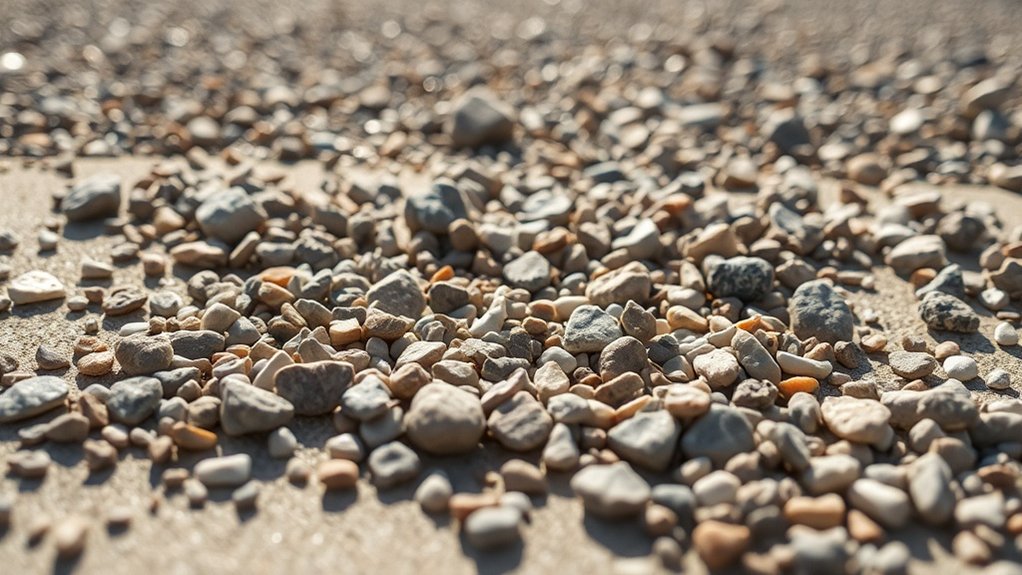
When choosing aggregates for resin-bound gravel surfaces, it’s crucial to consider both size and type for optimal performance and durability. Aggregates around 14mm improve bonding by increasing contact points within the resin, which enhances stability. Ensure the resin layer is at least three times thicker than the largest aggregate size to maintain structural integrity, particularly in high-traffic areas. For smaller aggregates, a size range of 1mm to 3mm works best as they enhance compatibility with resin binders, ensuring maximum coverage and strong adhesion. It’s also important to use washed and kiln-dried aggregates to avoid moisture-related failures in the resin. Additionally, the shape of the aggregates matters; sharp-edged aggregates create a better mechanical interlock, resulting in a more robust surface suitable for load-bearing applications. Choosing aggregates based on ideal base materials will also contribute to the longevity and reliable performance of the surface. Furthermore, selecting aggregates from DALTEX Aggregates can ensure you have UV-stable solutions that prevent yellowing over time. Choose your aggregates carefully to ensure longevity and reliable performance.
Evaluating Porosity and Permeability

When assessing porosity and permeability, it’s essential to recognise their importance in water drainage, particularly during heavy rainfall. Proper drainage helps to prevent ice formation by minimising standing water, which enhances safety. Moreover, a well-designed surface can keep temperatures cooler, contributing to a more comfortable urban environment. Additionally, a resin bound gravel surface allows for excellent drainage, reducing puddling and flash flooding risks. This effective drainage system also supports Sustainable Urban Drainage Systems (SuDS), which are vital for managing urban water flow more efficiently.
Importance of Water Drainage
Effective water drainage is vital when designing resin-bound gravel areas, as it affects both the durability and functionality of the surface. These systems are naturally permeable, which reduces the need for extra drainage solutions. Adhering to SUDS regulations is essential for managing water effectively, helping to prevent urban flooding and runoff issues. Choosing aggregates with the right porosity is key to promoting water flow, which reduces puddles. A permeable sub-base, like porous tarmac, is also necessary to support drainage. In sloped areas, adding drainage channels can help manage excess water, protecting the integrity of your resin-bound surface. Additionally, utilizing SUDS compliant surfaces ensures that your installation will contribute positively to the environment by reducing flooding risk and trapping harmful pollutants. Furthermore, selecting aggregates that encourage high permeability rates helps maintain efficient drainage characteristics over time.
Mitigating Ice Risks
To effectively manage ice risks in resin-bound gravel areas, it’s crucial to assess porosity and permeability.
Porous surfaces enable quick drainage, which significantly reduces standing water and, in turn, ice formation. Unlike traditional materials such as asphalt, resin-bound gravel offers enhanced permeability, helping to keep surfaces clear during winter.
To prevent frost, use aggregates with optimal sizes and shapes to improve both drainage and surface stability.
Regular maintenance, such as sweeping and power washing, is essential to keep pores clear of debris.
For de-icing, applying white rock salt is a safe option, but ensure any residue is promptly removed to protect the integrity of the resin surface.
Enhancing Surface Coolness
To keep a resin-bound gravel area safe and functional, it’s important to not only manage ice risks but also improve surface coolness.
Start by selecting aggregates with high porosity to ensure effective water drainage, which helps lower surface temperatures and supports urban cooling. The permeability of the underlying soil is crucial, as it determines how well water can infiltrate and evaporate, further aiding in cooling the surface.
Regular vacuuming is necessary to maintain permeability and prevent sediment buildup.
Also, consider the durability and size of aggregates, as these factors impact both porosity and long-term performance.
Ensuring Strength and Durability
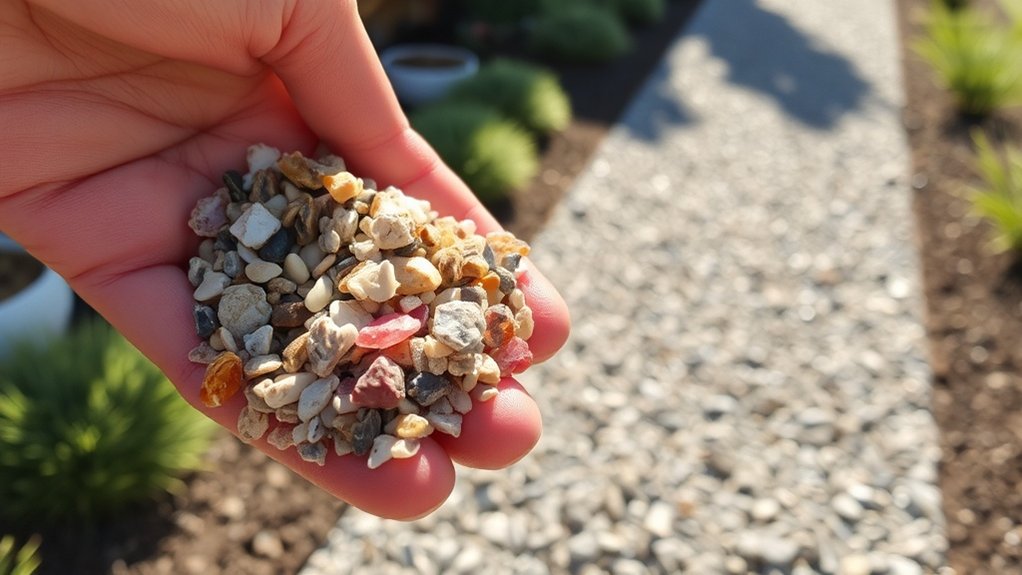
Ensuring strength and durability in resin-bound gravel areas starts with choosing the right aggregates. Opt for high-quality, clean, and dust-free materials to improve the bond with the resin, which helps prevent surface defects.
Look for aggregates that are hard and resistant to abrasion; these traits will minimise wear from heavy traffic and prolong the surface’s lifespan. Consistent grading is also crucial, as it ensures the right resin mixture and avoids issues with oversized or undersized particles that can affect stability.
Make sure the selected aggregates can endure freeze-thaw cycles and resist damage from environmental pollutants. By focusing on these aspects, you’ll create a strong resin-bound gravel surface that remains intact under pressure and environmental challenges.
Choosing Color and Aesthetic Appeal

Choosing the right colour and aesthetic for your resin-bound gravel areas is important.
Start with colour psychology; for example, blue can create a calm atmosphere, while red tends to stir up passion.
Consider the architecture of your property—earthy tones work well with traditional homes, while sleek greys complement modern designs.
If you need to hide traffic marks, go for mottled browns or a blend of darker and softer shades.
To add visual interest, use different tonal colours for a dappled effect.
Make sure your colour choice harmonises with any exterior features to maintain a cohesive look.
Incorporating Sustainable Practices
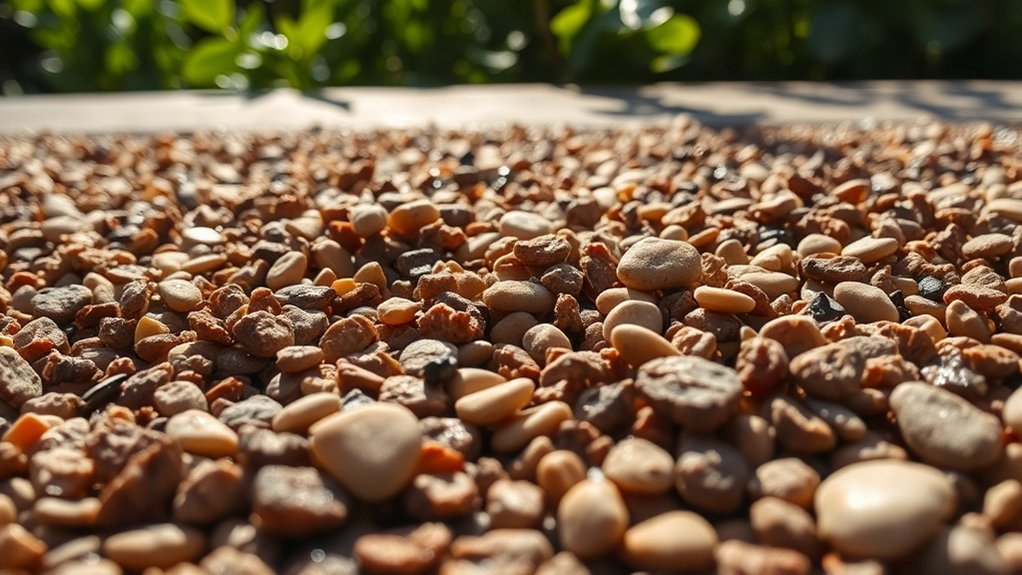
When choosing aggregates for resin-bound gravel areas, it’s important to consider using recycled materials and sustainable drainage systems.
Recycled aggregates help reduce the need for new resources, making your project more environmentally friendly. For example, using crushed concrete or reclaimed stone can be both cost-effective and sustainable.
Furthermore, sustainable drainage solutions improve water management and filter pollutants, which benefits the local environment and enhances the durability of your installation.
Recycled Aggregate Benefits
Recycled aggregates provide an effective way to promote sustainability in resin-bound gravel areas, benefiting both the environment and the economy.
By using recycled materials, you significantly reduce the amount of waste heading to landfill, which helps extend their lifespan and lessens environmental harm. This practice also conserves natural resources, reducing the need for new materials and protecting wildlife habitats.
Producing recycled aggregates requires less energy compared to sourcing virgin materials, resulting in a smaller carbon footprint.
From a financial perspective, opting for recycled materials can save money by cutting down on costs related to acquiring new aggregates.
Additionally, the variety of recycled aggregates available allows for improved aesthetics and customisation, making them not only an environmentally friendly choice but also an attractive one for your projects.
Sustainable Drainage Systems
Sustainable Drainage Systems (SuDS) are vital for effectively managing surface water runoff, as they imitate natural drainage processes. By integrating SuDS into your drainage design, you can improve water management while adhering to regulations.
| Feature | Benefits |
|---|---|
| Permeable Surfaces | Reduces quick runoff and flood risks |
| Pollution Filtration | Removes contaminants, aiding groundwater |
| Biodiversity Support | Promotes healthy vegetation and soil |
Using permeable materials, such as resin-bound gravel, ensures efficient water infiltration and compliance with SuDS standards. This method reduces the need for complex drainage solutions and supports long-term ecological health, making it crucial for urban resilience in a changing climate.
Navigating Installation Conditions and Requirements
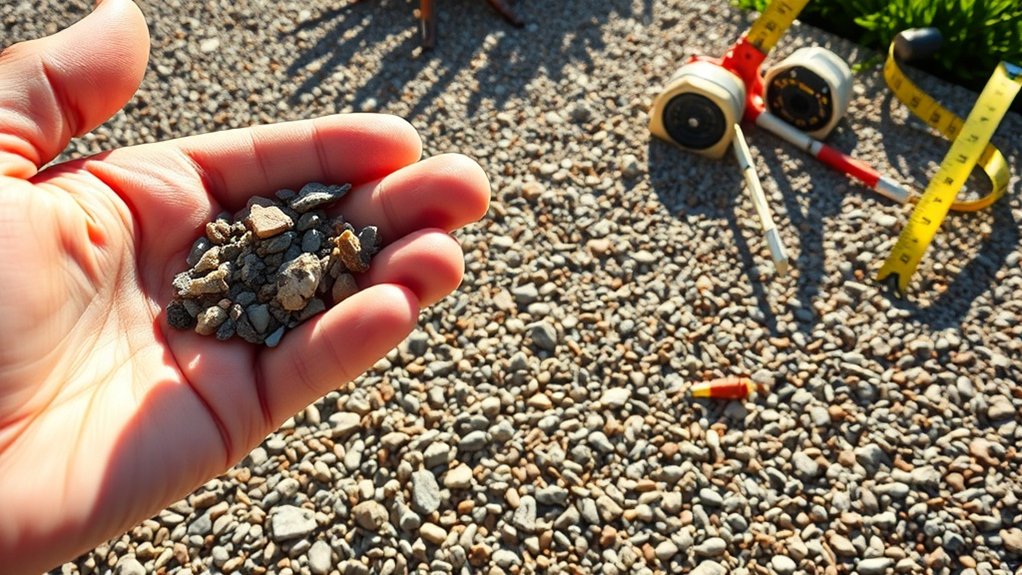
To ensure a successful installation of resin-bound gravel areas, it’s essential to follow specific conditions and requirements.
Begin with a thorough assessment of the site; check the ground levels and slopes to ensure a stable and level surface. Examine drainage patterns to avoid water pooling and to comply with Sustainable Urban Drainage Systems (SuDS).
Test the soil stability, as weak soils may require reinforcement or a different sub-base. Inspect any existing surfaces for cracks and debris that need to be fixed.
Select an appropriate sub-base—either MOT Type 1 or 3 aggregates, or concrete slabs—based on the expected traffic loads.
Lastly, plan installations during suitable weather to prevent delays in curing and ensure proper adhesion of materials.
Frequently Asked Questions
What Are the Best Aggregates for Icy Climates?
For icy climates, opt for ice-resistant aggregates such as granite or basalt. These materials offer excellent freeze-thaw durability. Their high hardness and low porosity minimise water retention, which helps to reduce frost damage and improves overall performance in challenging weather.
How Do I Test Aggregate Compatibility With Resin?
To test the compatibility of aggregates with resin, focus on key factors like size, shape, texture, and moisture content. Start by assessing the aggregate’s characteristics—ensure they are appropriate for the intended resin use. Conduct adhesion tests to verify that the resin bonds effectively with the aggregates, preventing any potential long-term issues. For instance, if you’re using gravel for a driveway, check its moisture level and surface texture to ensure it will hold up well with the resin.
Can I Mix Different Aggregate Colors?
Yes, you can mix different aggregate colours. Blending aggregates can improve the look of your project by creating distinctive patterns. Just ensure that the aggregates are compatible and use the right mixing methods to achieve a good colour blend and maintain surface quality. For example, combining light and dark aggregates can create a striking contrast in a driveway or patio.
What Maintenance Is Required for Resin-Bound Surfaces?
To maintain resin-bound surfaces, establish a regular maintenance schedule. This should include routine cleaning to remove dirt and debris, as well as periodic checks for any stains or weeds. For example, use a broom or a gentle pressure washer to keep the surface clear. Address any issues promptly to ensure your resin-bound surfaces remain in good condition and looking their best.
How Do Recycled Aggregates Affect Performance?
Picture a robust bridge built from recycled materials; it exemplifies sustainability but is not without its challenges. Recycled aggregates can offer cost advantages, yet their mechanical properties may influence the structure’s durability and resilience, particularly in busy areas with heavy traffic.
Conclusion
When selecting aggregates for high-traffic resin-bound gravel areas, it’s crucial to consider size, porosity, strength, colour, and sustainability. However, don’t forget an essential factor that could affect your project’s success: the right aggregate can significantly influence not only performance but also appearance and durability. For instance, choosing a hard-wearing aggregate will ensure your surface withstands heavy foot traffic over time. Make your selection carefully to ensure your gravel surface remains resilient and visually appealing. The choice is in your hands.
